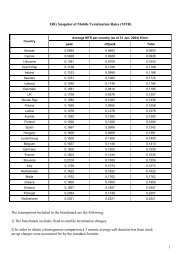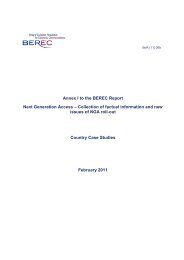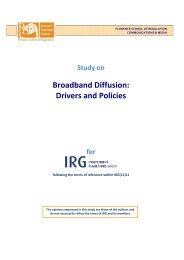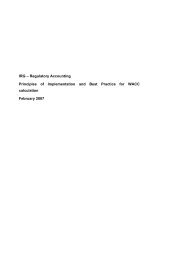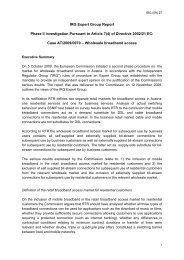16 Rev2b NGA Opinion Supplementary doc - IRG
16 Rev2b NGA Opinion Supplementary doc - IRG
16 Rev2b NGA Opinion Supplementary doc - IRG
You also want an ePaper? Increase the reach of your titles
YUMPU automatically turns print PDFs into web optimized ePapers that Google loves.
ERG (07) <strong>16</strong>rev2b <strong>NGA</strong> <strong>Opinion</strong> <strong>Supplementary</strong> Doc 23 / 69<br />
Competitors in general consider that regulation has to grant access to a wide set of wholesale<br />
offers – access to ducts, unbundling of the fibre local loop, bitstream – enabling them to<br />
choose which offer to take.<br />
ERG Considerations<br />
The ERG notes that the two options proposed to regulate access to the ducts of the incumbent<br />
through market analysis (through Market 11 including fibre / through a separate market)<br />
have both their pros and cons. It is acknowledged that defining a duct market may not be an<br />
easy task, as ducts may not be strictly considered electronic communication.<br />
However, the ERG proposes to maintain the two options identified in its consultation <strong>doc</strong>ument.<br />
ad 4.4.3/4.4.4 Role of symmetrical regulation and its relation to SMP regulation<br />
Consultation Comments<br />
With regard to facility sharing several comments advocate a symmetrical approach to regulation<br />
(BT, DTAG, ETNO, Fastweb, KPN, OTE, TI). These comments refer to the availability of<br />
infrastructures from other telecommunications operators, electricity companies, municipalities<br />
or public utilities. Referring to FttH roll-outs in Paris, Vienna and Milan also other infrastructures<br />
like water pipes, sewers, or underground railway systems are exploitable. One comment<br />
calls for open access to passive infrastructures in the public domain. According to this<br />
view “all ducts and poles should be sharable” (Alcatel-Lucent).<br />
One comment states that NRAs can assess on a case-by-case basis the availability of infrastructures<br />
in different regional geographies (FT). According to another comments public policy<br />
initiatives in non-competitive areas should aim at removing barriers to the development of<br />
facilities based competition. Thus, newly created duct networks could then be offered by public<br />
authorities on a non-discriminatory basis (Corning).<br />
Nevertheless, in the first instance, it needs to be analysed whether ducts constitute a bottleneck<br />
in a specific region. If there is such a bottleneck, then not only incumbent’s ducts should<br />
be looked at (DTAG).<br />
According to one comment, the need to consider all existing ducts is already mandated by<br />
Art. 12 (2) a) AD requiring that NRAs when evaluating possible access obligations shall take<br />
into account the technical and economic viability of using or installing competing facilities<br />
(ETNO). Thus, limiting the analysis to ducts used for electronic communication purposes is<br />
not in line with EU law and would lead to disproportionate obligations.<br />
Moreover, ducts are not electronic communications services and as such cannot constitute a<br />
separate electronic communications market (ETNO). For this reason the ERG-proposal of<br />
defining a market for ducts “used for electronic communications puposes” is ill-perceived.<br />
Another comment considers a classification of ducts as “ancillary service” as unfounded and<br />
incompatible with the Framework (DTAG).<br />
Although symmetrical approach is preferable, any such new obligation in the Framework<br />
need to be justified, proportionate and broadly consulted upon by the Commission (ETNO).<br />
The option of using alternative infrastructures, as proposed by those advocating a symmetrical<br />
approach, is not uncontested. One comment considers these alternatives for connecting<br />
the backhaul network to the SDF as “regulatory unfeasible alternative” due to the high trans-



